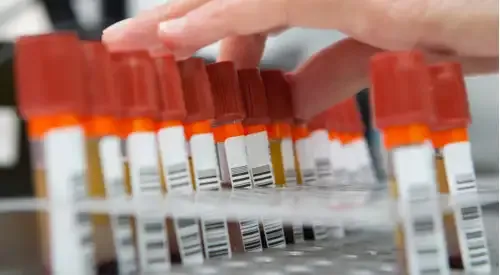Scarlet fever
"The use of penicillin in infected patients can sometimes prevent the development of the disease".
DR. JOSÉ RAMÓN YUSTE ARA
SPECIALIST. INFECTIOUS DISEASES SERVICE

Scarlet fever is an acute infectious-contagious disease that affects children and whose symptoms are fever, pharyngo-tonsillitis, exanthema and peeling.
It is transmitted from the sick person to the healthy person through the air by saliva droplets (Pflügge drops). Carriers can also spread it through objects or food (although less frequently).
The prognosis is good with proper treatment. In some cases it can be serious: toxic forms and septic forms.

What are the symptoms of scarlet fever?
- Incubation period: lasts between 3 and 5 days and is asymptomatic.
- Invasion period: 12-24 hours with abrupt onset: high fever, vomiting and headache, painful pharyngo-tonsillitis, enanthem (red spots) on the veil of the palate and very saburral tongue (covered with a whitish layer but with red spots and edges).
- Exanthema or state period: lasts approximately 3-4 days. It begins with a scarlet red, fine, more intense exanthema in the skin folds. The tongue flakes off and appears red with prominent papillae, giving it a raspberry appearance (typical of scarlet fever).
- Period of desquamation or decline: can persist for weeks.
The most common symptoms are:
- High fever.
- Vomiting.
- Headache.
- Sore throat.
- Scarlet red rash.
Do you have any of these symptoms?
You may have scarlet fever
What are the causes of scarlet fever?
It is caused by a bacterium, group A hemolytic streptococcus, through its erythrogenic toxins A, B, and C.
Scarlet fever leaves long-lasting immunity to the toxin, but the child can become infected with other types or varieties of streptococcus.
What are the complications of scarlet fever?
Complications can be:
- Precocious: they appear almost at the same time as the disease (by extension of the streptococcal infection to neighbouring tissues), such as otitis media, mastoiditis, cervical adenitis, laryngitis, bronchopneumonia...
- Late: glomerulonephritis, rheumatic fever, osteomyelitis
¿Cómo se diagnostica la escarlatina?

El diagnóstico de la escarlatina se realiza por la sintomatología clínica confirmándose a través de pruebas analíticas en las que se detecta:
Presencia del estreptococo en exudado faríngeo.
Antiestreptolisinas en suero (desarrollo de anticuerpos).
Aumento de leucocitos y eosinófilos (glóbulos blancos) en la sangre.
La evolución puede ser muy diversa y las formas clínicas pueden ser desde malignas (tóxica, séptica) a benignas (latente, frustrada).
La enfermedad deja inmunidad duradera frente a la toxina.
How is scarlet fever treated?
- Abundant liquids.
- Rest during the feverish period.
- Analgesics and antipyretics.
- Antibiotics: penicillin is the antibiotic of choice and initiation, except in allergic people in whom erythromycin will be used. The duration will be 10 days, since otherwise the germ may not be eradicated, and the subject may become a carrier.
Where do we treat it?
IN NAVARRE AND MADRID
The Infectious Diseases Service
of the Clínica Universidad de Navarra
This area works on the diagnosis and treatment of diseases produced by an infectious agent, which can be bacteria, virus, fungus and protozoa. Infections affect people by causing very different processes that can be located in any tissue of the human body, so it requires a specific approach.
This area carries out its activity on three fronts: care work, focused on the diagnosis and treatment of infectious diseases; teaching, with training of medical students, resident doctors and nurses; and research vocation, through the development of clinical and laboratory studies.
Organized in care units
- Infections associated with biomaterials.
- Nosocomial infections (multi-resistance).
- Infections in immunosuppressed patients.
- Community infection.
- Traveler's medicine.
- Prudent use and optimization program of anti-infective therapy.
- Control of infection by multi-resistant microorganisms.

Why at the Clinica?
- We perform the traveler's assessment and analytical tests in less than 24 hours.
- Second opinion consultation when the infection has not yet been resolved.
- We ensure the prudent use of antibiotics.



